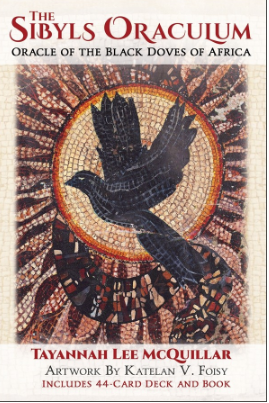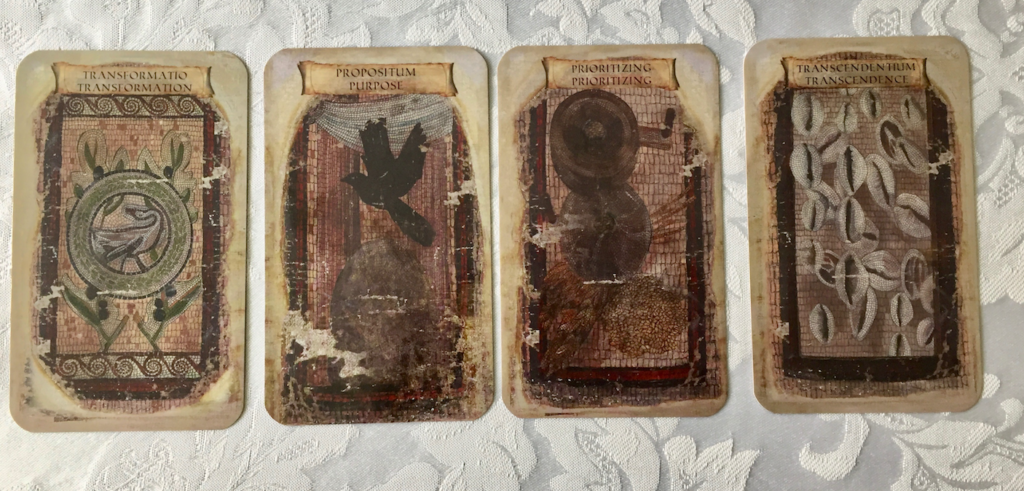The Sybil’s Oraculum, by Tayannah Lee McQuillar
The good people at Inner Traditions sent me a copy of The Sybil’s Oraculum: Oracle of the Black Doves of Africa, created by Tayannah Lee McQuillar, with artwork by Katelan V. Foisy. The packaging is striking:

The Sibyl’s Oraculum
The cover art on the box repeats on the book cover and the card backs. Done in the style of early Libyan mosaics, the art is evocative of the time and place of the early Sibyls, and creates a strong visual connection to the deck’s energies.
The book is not a standard little white book, but a full-size paperback of 140 pages. McQuillar opens with the history of the Sybils, which was new to me, and fascinating. The common idea that the Sibyls originated in ancient Greece is actually incorrect, and McQuillar discusses how the Greeks discovered the Sibyls when they invaded Africa, and took the tradition home with them (as with so many other things in their conquests, like all conquerors). She also discusses the continuation of the tradition, and its presence in modern cultures in Africa.
The cards draw on a variety of African myths and traditions, giving them a distinct richness and depth of meaning for contemplation. McQuillar also composed an epigram for each card, adding to the interpretative experience.
McQuillar emphasizes that the oracle is not a typical fortune-telling deck. On page 20, she writes: “It is a cartomantic method of divination designed to facilitate self-examination and decision-making to improve the likelihood of success in all undertakings.”
The next section of the book contains the Core Issue Assessment, in which you consider your current beliefs about yourself, your life, and the way things work (or don’t work). It takes some time, but the answers are illuminating—if you answer honestly. You could skip this part and jump straight to working with the cards, but the discussion of the questions and answers adds so much more to work with, it is more than worth the time to do to assessment.
Thoroughly grounded in the deck’s approach and your own perspective, it’s time to settle in and do a reading with the oracle.
The deck is divided into four types of cards, reflecting various aspects of the situation. The backs of the cards have the same image, but each is shaded in black, red, copper, or blue, indicating its type. The cards are shuffled as a complete set, and then one card of each type is drawn from the deck. For me, the distinction between the red and copper wasn’t especially clear, and a border of the assigned color would have made it easier to determine. Some of the card images also printed quite dark, so I recommend working with sufficient light so you can fully see the wonderful images.
Posing questions to the oracle is done differently than in other divination systems, although I like this method, and am going to use it with other oracles to see how it works.
“The seeker poses a question phrased in a neutral way using a simple ‘Comment on . . .’ method. For example:
*Comment on getting back together with . . .
*Comment on loaning money to . . . ”
*Comment on what lesson I need to master in this lifetime.
*Comment on the meaning of the dream I had last night.”
Since I don’t work with oracles in a predictive manner, this method appeals to me greatly.
I formulated a question, and came up with this spread:

Reading the epigrams and the card meanings in the book, and considering my responses to the images, I came away feeling encouraged—they key words on each card are positive in themselves, and the reading and contemplation bore out that sense.
The Sibyl’s Oraculum truly is unlike other divination systems I have worked with, not just in its images and symbolism, but in its clarity—there is no ambiguity or vagueness, no wiggle room to slant the interpretation to be what you want it to be, rather than what it is.
It not only gives much to think about, it provides a solid foundation for processing those ideas in a clear and completely honest manner.
I am intrigued by the Sibyl’s Oraculum, and look forward to working with it!
